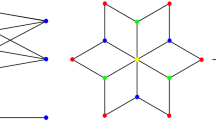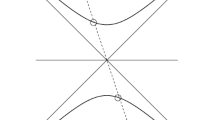Abstract
We study the geometry of the Margulis region associated with an irrational screw translation \(g\) acting on the \(4\)-dimensional real hyperbolic space. This is an invariant domain with the parabolic fixed point of \(g\) on its boundary which plays the role of an invariant horoball for a translation in dimensions \({\le }\)3. The boundary of the Margulis region is described in terms of a function \(\fancyscript{B}_{\alpha }: [0,\infty ) \rightarrow {\mathbb {R}}\) which solely depends on the rotation angle \(\alpha \in {\mathbb {R}}/{\mathbb {Z}}\) of \(g\). We obtain an asymptotically universal upper bound for \(\fancyscript{B}_{\alpha }(r)\) as \(r \rightarrow \infty \) for arbitrary irrational \(\alpha \), as well as lower bounds when \(\alpha \) is Diophantine and the optimal bound when \(\alpha \) is of bounded type. We investigate the implications of these results for the geometry of Margulis cusps of hyperbolic \(4\)-manifolds that correspond to irrational screw translations acting on the universal cover. Among other things, we prove bi-Lipschitz rigidity of these cusps.




Similar content being viewed by others
Notes
We don’t know if strike triples can actually occur.
References
Apanasov, B.: Cusp ends of hyperbolic manifolds. Ann. Glob. Anal. Geom. 3, 1–11 (1985)
Apanasov, B.: Conformal Geometry of Discrete Groups and Manifolds. Walter de Gruyter, Germany (2000)
Benedetti, R., Petronio, C.: Lectures on Hyperbolic Geometry. Springer, Berlin (2003)
Erlandsson, V.: The Margulis region and screw parabolic elements of bounded type. arXiv:1209.5680. To appear in Bull. Lond. Math. Soc.
Erlandsson, V., Zakeri, S.: A discreteness criterion for groups containing parabolic isometries. arXiv:1304.2298. To appear in Groups, Geometry and Dynamics, Contemp. Math., AMS
Hardy, G., Wright, E.: An Introduction to the Theory of Numbers, 5th edn. Oxford University Press, Oxford (1980)
Herman, M.: Sur la conjugaison différentiable des difféomorphismes du cercle à des rotations. Publ. Math. de l’IHÉS 49, 5–233 (1979)
Jørgensen, T.: On discrete groups of Möbius transformations. Am. J. Math. 98, 739–749 (1976)
Kellerhals, R.: Collars in \(\text{ PSL }(2,\mathbb{H})\). Ann. Acad. Sci. Fenn. 26, 51–72 (2001)
Kim, Y.: Quasiconformal stability for isometry groups in hyperbolic 4-space. Bull. Lond. Math. Soc. 43, 175–187 (2011)
Ohtake, H.: On discontinuous subgroups with parabolic transformations of the Möbius groups. J. Math. Kyoto Univ. 25, 807–816 (1985)
Ratcliffe, J.: Foundations of Hyperbolic Manifolds. Springer, Berlin (1994)
Shimizu, H.: On discontinuous groups operating on the product of the upper half planes. Ann. Math. 77, 33–71 (1963)
Susskind, P.: The Margulis region and continued fractions, complex manifolds and hyperbolic geometry (Guanajuato, 2001). Contemp. Math. 311, 335–343 (2002)
Thurston, W.: Three-Dimensional Geometry and Topology, vol. 1. Princeton University Press, Princeton (1997)
Tukia, P.: Quasiconformal extension of quasisymmetric mappings compatible with a Möbius group. Acta Math. 154, 153193 (1985)
Waterman, P.: Möbius transformations in several dimensions. Adv. Math. 101, 87–113 (1993)
Acknowledgments
We are grateful to Ara Basmajian for sharing his knowledge and lending his support at various stages of this project. We also thank Perry Susskind for useful conversations on the topics discussed here.
Author information
Authors and Affiliations
Corresponding author
Appendix: On arithmetical characterization of presence
Appendix: On arithmetical characterization of presence
The problem we investigate here is when a given denominator \(q_n\) in the continued fraction expansion of an irrational number \(\alpha \) is present in the boundary function \(\fancyscript{B}_{\alpha }\) (see Sect. 3). We need only consider the case where \(a_{n+1}=1\) since Corollary 3.8 guarantees that \(q_n\) is present when \(a_{n+1} \ge 2\). Assuming \(a_{n+1}=1\), the same corollary and the definition of fair triples show that
By the formula (13), this condition can be written as
The right side of the inequality in (24) is easily computed:
where
To estimate the left side of the inequality in (24), we use the inequalities
which can be easily proved using calculus. Since the denominator \(q_6\) is always \(\ge 13\), by Lemma 2.7(ii),
It follows that
Introduce the quantity
which by Lemma 2.7(iii) satisfies
Note that since \(a_{n+1}=1\), we have \(\Vert q_{n-1} \alpha \Vert = \Vert q_{n} \alpha \Vert + \Vert q_{n+1} \alpha \Vert \), which shows
Thus, for \(n \ge 5\),
and
Introducing the rational functions
the condition (24) and the above estimates can be summarized as
and
where \(\mu , \lambda \) satisfy (25) and (26).
The following can be deduced from (27) and (28) (compare the graphs of \(X,Y,Z\) in Fig. 5).
-
If \(a_{n} \ge 3\) and \(a_{n+2} \ge 3\), then \(\mu , \lambda >3\) and
$$\begin{aligned} \frac{\delta _{n}-\delta _{n+1}}{\delta _{n-1}-\delta _{n}} > Z(\lambda )>Z(3)>X(3)>X(\mu ). \end{aligned}$$so \(q_{n}\) is absent.
-
If \(a_{n}=2\) and \(a_{n+2} \ge 5\), then \(2<\mu <3, \lambda >5\) and
$$\begin{aligned} \frac{\delta _{n}-\delta _{n+1}}{\delta _{n-1}-\delta _{n}} > Z(\lambda )>Z(5)>X(2)>X(\mu ), \end{aligned}$$so \(q_{n}\) is absent.
-
If \(a_{n} \ge 5\) and \(a_{n+2}= 2\), then \(\mu >5, 2<\lambda <3\) and
$$\begin{aligned} \frac{\delta _{n}-\delta _{n+1}}{\delta _{n-1}-\delta _{n}} > Z(\lambda )>Z(2)>X(5)>X(\mu ), \end{aligned}$$so \(q_{n}\) is absent.
-
If \(a_{n}=1\) and \(a_{n+2} \le 2\), then \(1<\mu <2, 1<\lambda <3\) and
$$\begin{aligned} \frac{\delta _{n}-\delta _{n+1}}{\delta _{n-1}-\delta _{n}} < Y(\lambda )<Y(3)<X(2)<X(\mu ), \end{aligned}$$so \(q_{n}\) is present.
-
Finally, if \(a_{n}=2\) and \(a_{n+2}=1\), then \(2<\mu <3, 1<\lambda <2\) and
$$\begin{aligned} \frac{\delta _{n}-\delta _{n+1}}{\delta _{n-1}-\delta _{n}} < Y(\lambda )<Y(2)<X(3)<X(\mu ), \end{aligned}$$so \(q_{n}\) is present.
These findings are summarized in Fig. 6. In all other cases, the presence or absence of \(q_n\) also depends on other partial quotients such as \(a_{n-1}, a_{n+3}\), etc.
Rights and permissions
About this article
Cite this article
Erlandsson, V., Zakeri, S. On Margulis cusps of hyperbolic \(4\)-manifolds. Geom Dedicata 174, 75–103 (2015). https://doi.org/10.1007/s10711-014-0005-0
Received:
Accepted:
Published:
Issue Date:
DOI: https://doi.org/10.1007/s10711-014-0005-0






